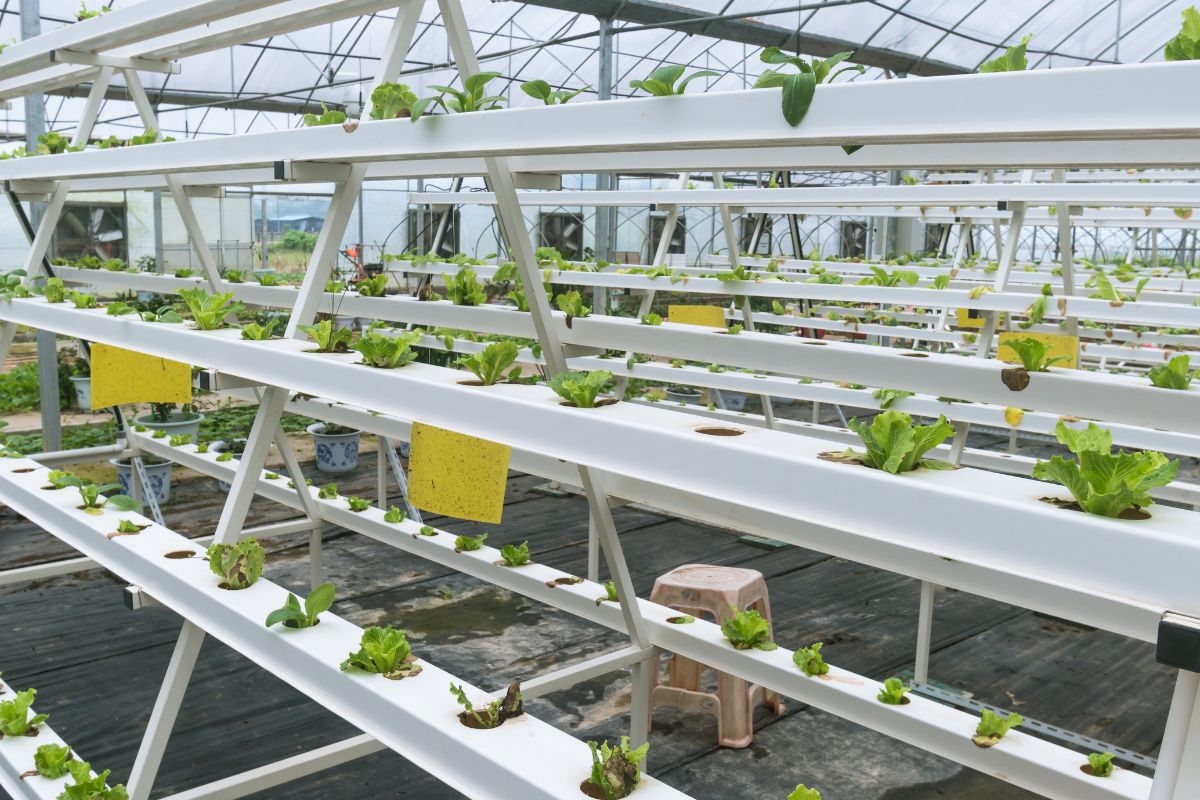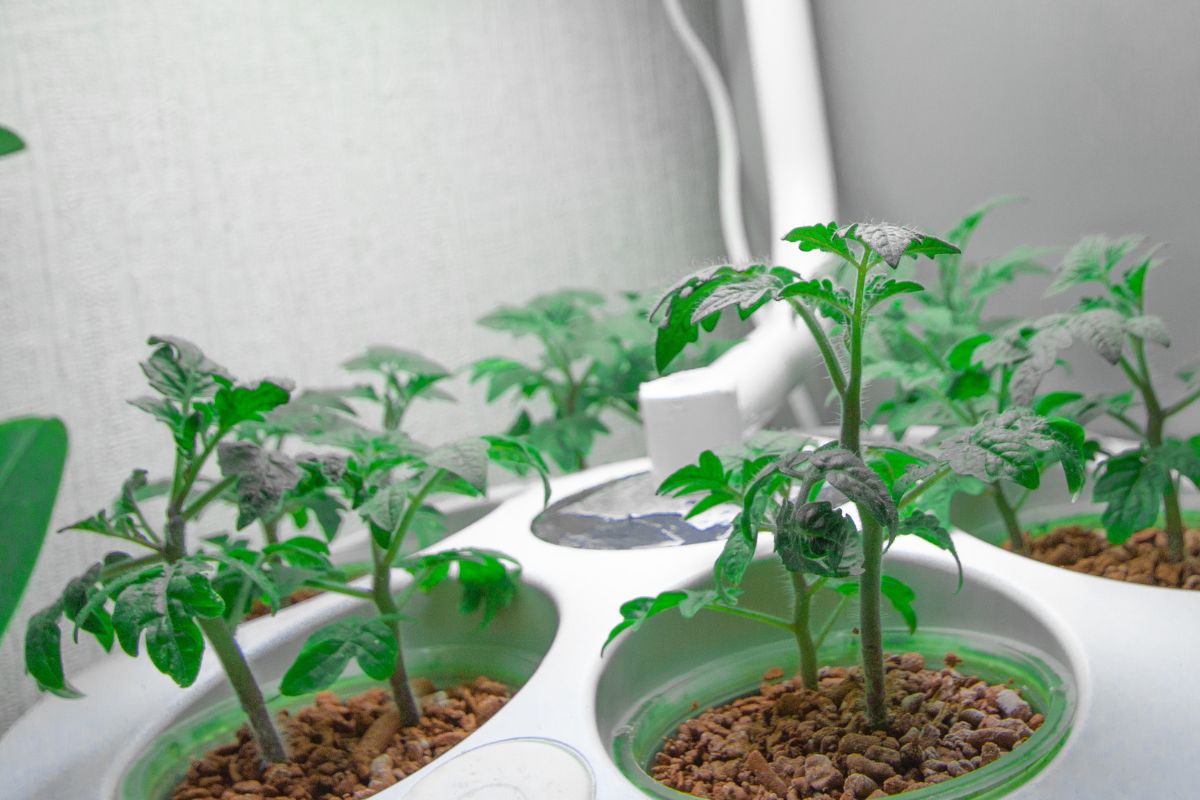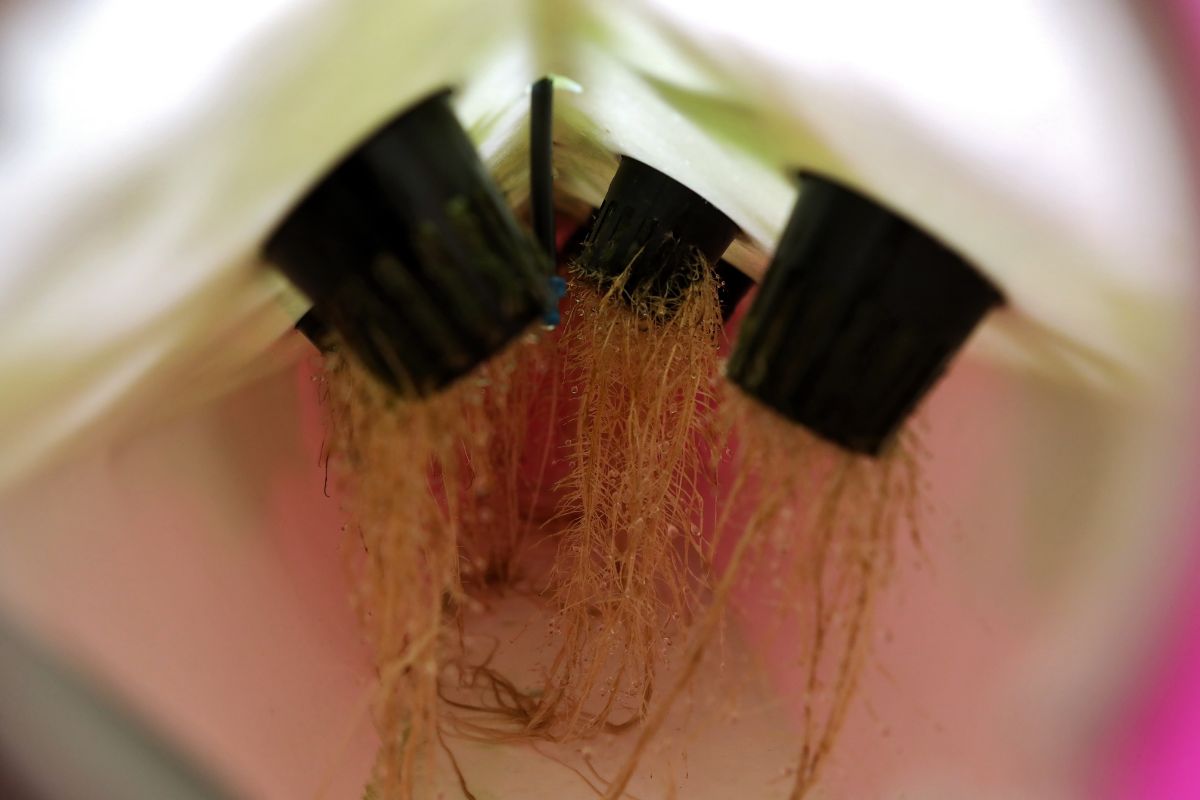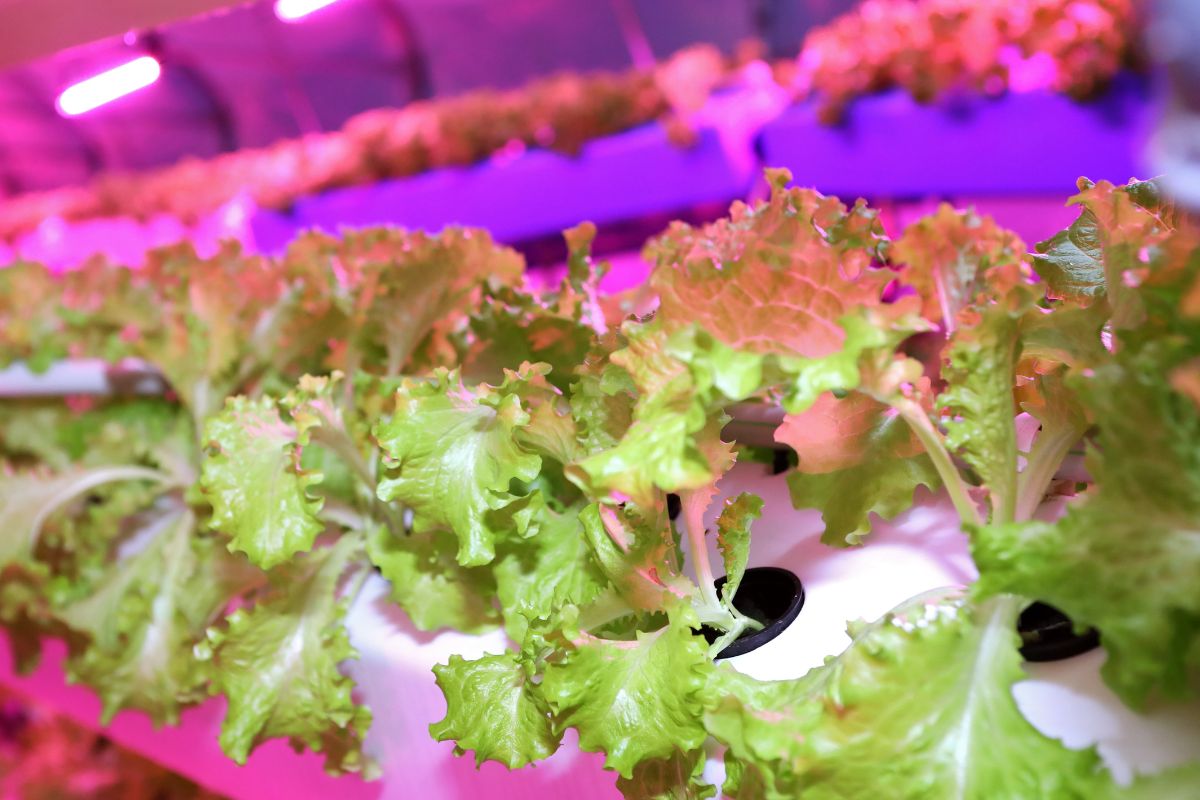I’ve always been fascinated by innovative gardening systems. Aeroponics is a method of growing plants without soil where the plant’s roots hang in the air.
You might be wondering how aeroponics compares to hydroponics. Both methods do not require soil, but there’s a key difference. In hydroponics, plant roots sit in nutrient-rich water or a special growing medium. Aeroponics takes it a step further. The roots dangle freely in the air and then get sprayed with a nutrient solution.
This unique setup in aeroponics can lead to even quicker growth. It also uses nutrients more efficiently. That’s why it’s gaining popularity in modern agriculture.
I’m excited to explore aeroponics and all its benefits for growing plants. Have you ever tried any soilless gardening methods?
- Related article: Explore Hydroponics
6 Key Takeaways on Aeroponics
- Aeroponics grows plants without soil by spraying a nutrient-rich mist directly onto plant roots in the air.
- Plants in aeroponic systems often grow faster and bigger due to their unrestricted root growth and constant nutrient access.
- This method has been used in space missions because it reduces weight and resource usage.
- There are various aeroponic systems. Each has its benefits and complexities.
- Aeroponics works well for leafy greens, herbs, and some vegetables, but is less effective for root crops that need more support.
- Setting up and maintaining an aeroponic system can be costly and complex, requiring careful monitoring of nutrients, water levels, and system components.
What Is Aeroponics?

Aeroponics is a process of growing plants without soil. It’s like a hydroponic system but with a twist. In aeroponics, we don’t submerge roots in water or use soil. Instead, we spray a fine nutrient mist directly onto the dangling roots of the plant.
This setup lets roots grow freely as no soil or pot holds them back. As a result, aeroponic plants often grow bigger and faster.
NASA even tested aeroponics in space. Well, it’s not just because of how it sounds. This method cuts down on weight big time. No soil and less water mean lighter loads for space missions. Imagine trying to grow food in space. Every pound matters when you’re launching a rocket. Aeroponics could be a game-changer for long trips to Mars or beyond.
These plants aren’t just for eating. They can help make oxygen and clean water too. Who knew plants could be so useful in space?
Some folks use high-pressure aeroponics for even better results. This system creates an ultra-fine mist through mist heads ranging from 20-50 micrometers that roots love.
How Does Aeroponics Work?

With aeroponics, your plant’s roots hang in the air. They then get sprayed with a special water that has all the food they need. This mist comes from a pump that makes it super fine. The roots soak up nutrients faster this way.
Aeroponics is part of the bigger world of gardening systems. Commercial production often prefers soilless methods because they’re so efficient.
Maintaining this system can be quite tricky though. You need to watch the temperature and humidity closely. Water levels are super important too. Your plants’ roots are the key players here. Give them too much water and they might rot. Too little and they’ll dry up fast.
I’ve had my fair share of clogged nozzles too. Even with filters, they can be a pain. But once you get it right, the payoff is worth the effort. Aeroponic roots look different from the ones in soil. They’re whiter and fluffier because they have more access to oxygen.
Types of Aeroponics Systems

Let’s explore the main aeroponic types that can change your gardening game big time. Each method has its own cool features.
- High-Pressure Aeroponics (HPA) – This one’s the advanced option. It uses strong pumps to create a super fine mist for the roots. Very small water droplets improve nutrient uptake and oxygenation
- Low-Pressure Aeroponics (LPA) – A simpler version of HPA. It’s a low-pressure system that creates a coarser mist. It’s easier on the wallet but might not work as well.
- Nutrient Film Technique (NFT) – This type of aeroponics is primarily a hydroponic one. It uses a stream of nutrient-rich water that flows over plant roots, which are suspended in a channel. It’s not strictly aeroponic but can combined with it for added oxygenation.
- Vertical Aeroponics – Plants grow up instead of out with roots suspended in the air. Great for saving space!
- Tower Systems – Similar to vertical systems but uses special towers for the plants.
I’ve tried a few of these systems myself. The vertical one was a favorite due to the limited space in my small apartment balcony.
I recommend you start with an LPA system if you’re new to aeroponics. It’s easier to set up and maintain. You can always upgrade to an HPA system later if you get hooked.
What Can You Grow in Aeroponics?

Let’s talk about what you can grow in an aeroponic garden. You might think your options are limited when compared to traditional farming methods, but there’s still plenty to choose from. Lettuce, for example, shines in these systems. The nutrient-rich mist helps it grow faster than in regular soil.
On the other hand, root veggies like potatoes and carrots are no good. They need more support than aeroponics can give them. So what works best?
Here’s a list of plants that generally do well in aeroponics:
| Category | Plant |
| Leafy Greens | Lettuce, Spinach, Kale, Arugula |
| Herbs | Basil, Mint, Cilantro, Chives |
| Cruciferous Vegetables | Broccoli, Cauliflower |
| Fruiting Vegetables | Tomatoes, Peppers, Cucumbers |
| Microgreens | Mustard Greens, Broccoli Sprouts |
| Legumes | Beans, Peas |
Keep in mind that different plants have different requirements. Although this list might be helpful for your selection, you still need to do some trial and error to see what works best for your setup.
While leafy greens and herbs can sprout pretty fast, cruciferous vegetables require cooler temperatures. Fruiting vegetables in dwarf varieties would be easier to keep an eye on than their full-blown versions. A trellis should also help support bigger plants.
What Are the Benefits of Aeroponics?
Growing plants without soil?
Here’s why aeroponics is gaining popularity:
- Water Saver – You’ll use way less water than traditional gardening.
- Faster Growth – They get non-stop oxygen and nutrients.
- Increased Yield – You’ll get more veggies or fruits. Plants thrive in this setup.
- Reduced Use of Pesticides – Fewer bugs and diseases. No soil means fewer pests.
- Space Efficiency – It’s great for small spaces. You can stack plants vertically.
- Better Oxygenation – Roots love it. They get plenty of air, which makes them happy.
- Less Soil Management – No more digging in the dirt. Less mess, less work for you.
- Sustainable Agricultural Practice – Reduced water and resource usage. Less need for chemical inputs.
In aeroponics, the closed or semi-closed environment needs regular checks. It’s not something that you can do and forget. If you want to give it a shot, start small with herbs or leafy greens. They’re forgiving and grow quickly.
Have you ever tasted aeroponic produce? The flavor is often more intense because the plants get exactly what they need. No more bland supermarket veggies.
What Are the Disadvantages of Aeroponics?
Let’s take a look at a few drawbacks of aeroponics.
- High Startup Costs – Can be expensive due to the cost of equipment like pumps, misters, and nutrient delivery systems
- Complex Upkeep – System requires careful monitoring and maintenance
- Requires Technical Know-How – Demands a good understanding of plant nutrition, pH levels, and system management
- Relies on Electricity – Power outages or electrical failures can put plant health in danger without proper power backups
- Tricky Nutrient Balance – Imbalances can quickly affect plant health and growth.
- Risk of Water-Borne Diseases – Prone to water-borne pathogens or fungal issues if not properly managed
Aeroponics is quite a journey! So, is aeroponics right for you? It depends on how much time, money, and brainpower you’re willing to invest. It’s not for everyone, but if you’re up for a challenge, it might just be your thing!
What Is Aeroponics Final Thoughts
Aeroponics is doing wonders in the gardening world. Instead of soil, plants get their food from a fine mist that’s packed with nutrients. It’s super efficient with water and can make plants grow faster. Plus, it’s perfect if you’re short on space. I’ve seen amazing setups in tiny apartments!
Setting up an aeroponic system can be tricky and expensive. You need to know your stuff about plant nutrition and how to keep the system running smoothly. And don’t forget the need for a reliable power source.
Start small. Try growing some lettuce or herbs first. It’s a great way to get the hang of things before you go big.
Aeroponics can be a bit of a challenge, but it’s also super rewarding. It just takes some dedication and TLC to keep plants happy in this setup.
What Is Aeroponics FAQs
1. What Solution Is Used in Aeroponics?
There are several solutions that you can buy online for aeroponics. These blends usually include the following:
- Nitrogen
- Phosphorus
- Potassium
- Calcium
- Magnesium
These are the things that plants love. Always follow the manufacturer’s instructions. Even if they’re for smaller setups, they’re still your best bet.
2. Does Aeroponics Use Water?
Yes, it does! Instead of sitting in soil or water, the roots get sprayed with a fine mist. This mist contains a water and nutrient-rich solution that your plants need to thrive. The misting in aeroponics is super efficient. Your plants can easily absorb what they need without drowning their roots.
3. What Is the Meaning of Aeroculture?
Aeroculture or aeroponics is a method that suspends plant roots in the air and mists them with nutrients. No soil needed! Aeroculture is similar to hydroponics but not quite. Both use water to deliver nutrients. But in aeroculture, roots hang in the air instead of sitting in water.
If you want to learn more about hydroponics, make sure to check these helpful articles:
- Guide to Finding the Best AeroGarden
- Aquaponics Explained
- Guide to Indoor Smart Gardens
- Detailed Click and Grow Review
- https://scholarspace.manoa.hawaii.edu/server/api/core/bitstreams/bb7e5f35-8131-4ebf-a479-2f0fb3732bb9/content/
- https://www.charlestonsouthern.edu/aeroponics-whats-growing-on-here/
- https://smallfarms.cornell.edu/2010/10/aeroponics-a-piece-of-the-urban-farming-jigsaw-puzzle/
- https://terrascope2024.mit.edu/?page_id=313/
- https://spinoff.nasa.gov/Spinoff2008/ch_3.html/




